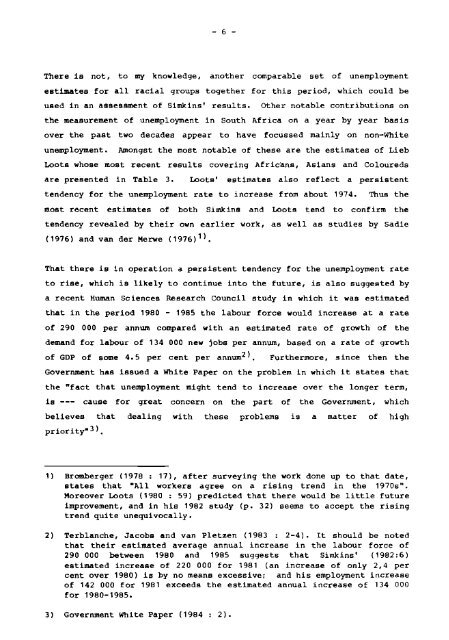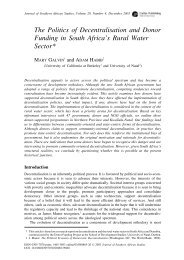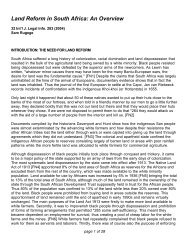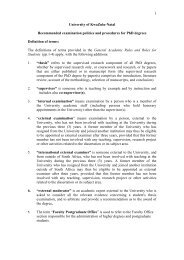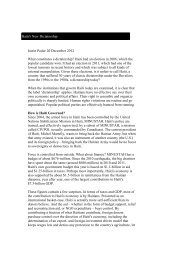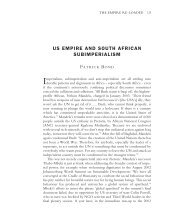Bell, Trevor : Unemployment in South Africa
Bell, Trevor : Unemployment in South Africa
Bell, Trevor : Unemployment in South Africa
You also want an ePaper? Increase the reach of your titles
YUMPU automatically turns print PDFs into web optimized ePapers that Google loves.
There is not, to my knowledge, another comparable set of unemployment<br />
estimates for all racial groups together for this period, which could be<br />
used <strong>in</strong> an assessment of Simk<strong>in</strong>s' results. Other notable contributions on<br />
the measurement of unemployment <strong>in</strong> <strong>South</strong> <strong>Africa</strong> on a year by year basis<br />
over the past two decades appear to have focussed ma<strong>in</strong>ly on non-White<br />
unemployment. Amongst the most notable of these are the estimates of Lieb<br />
Loots whose most recent results cover<strong>in</strong>g <strong>Africa</strong>ns, Asians and Coloureds<br />
are presented <strong>in</strong> Table 3. Loots' estimates also reflect a persistent<br />
tendency for the unemployment rate to <strong>in</strong>crease from about 1974. Thus the<br />
most recent estimates of both Simk<strong>in</strong>s and Loota tend to confirm the<br />
tendency revealed by their own earlier work, as well as studies by Sadie<br />
(1976) and van der Merwe (1976)').<br />
That there is <strong>in</strong> operation a persistent tendency for the unemployment rate<br />
to rise, which is likely to cont<strong>in</strong>ue <strong>in</strong>to the future, is also suggested by<br />
a recent Human Sciences Research Council study <strong>in</strong> which it was estimated<br />
that <strong>in</strong> the period 1980 - 1985 the labour force would <strong>in</strong>crease at a rate<br />
of 290 000 per annum compared with an estimated rate of growth of the<br />
demand for labour of 134 000 new jobs per annum, based on a rate of grovth<br />
of GDP of some 4.5 per cent per annum2). Furthermore, s<strong>in</strong>ce then the<br />
Government has issued a White Paper on the problem <strong>in</strong> which it states that<br />
the "fact that uneqloyment might tend to <strong>in</strong>crease over the longer term,<br />
is --- cause for great concern on the part of the Government, which<br />
believes that deal<strong>in</strong>g with these problems is a matter of high<br />
priority").<br />
1) Bromberger (1978 : 17). after survey<strong>in</strong>g the work done up to that date,<br />
states that "All workers agree on a ris<strong>in</strong>g trend <strong>in</strong> the 1970s".<br />
Moreover Loots (1980 : 59) predicted that there would be little future<br />
improvement, and <strong>in</strong> his 1982 study (p. 32) seems to accept the ris<strong>in</strong>g<br />
trend quite unequivocally.<br />
2) Terblanche, Jacobs and van Pletzen (1983 : 2-4). It should be noted<br />
that their estimated average annual <strong>in</strong>crease <strong>in</strong> the labour force of<br />
290 000 between 1980 and 1985 suggests that Simk<strong>in</strong>s' (1982:6)<br />
estimated <strong>in</strong>crease of 220 000 for 1981 (an <strong>in</strong>crease of only 2.4 per<br />
cent over 1980) is by no means excessive; and his employment <strong>in</strong>crease<br />
of 142 000 for 1981 exceeds the estimated annual <strong>in</strong>crease of 134 000<br />
for 1980-1985.<br />
3) Government White Paper (1984 : 2).


